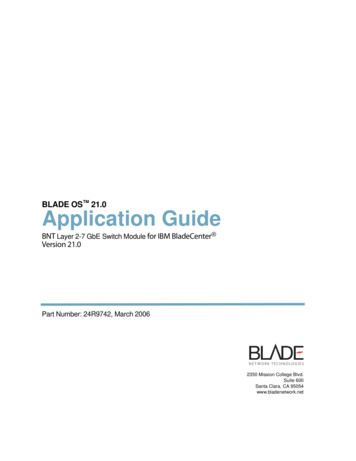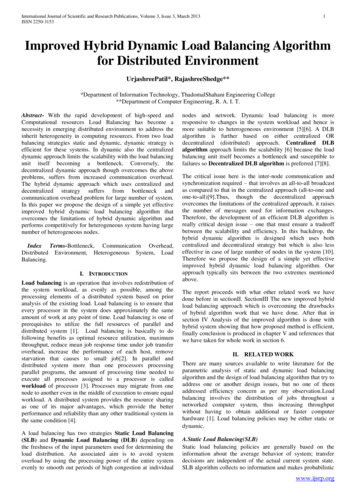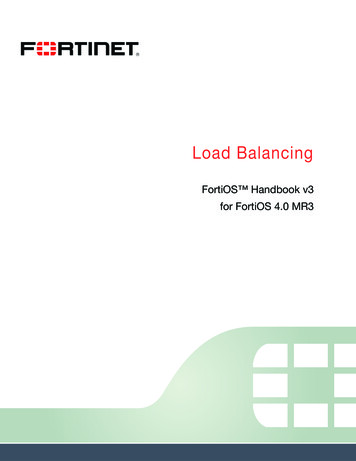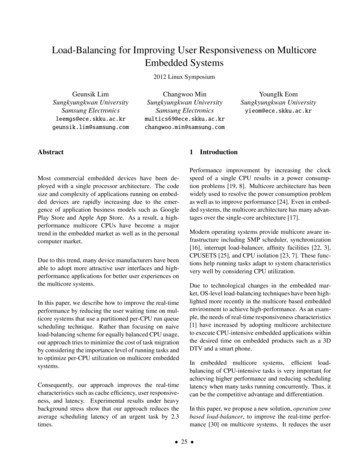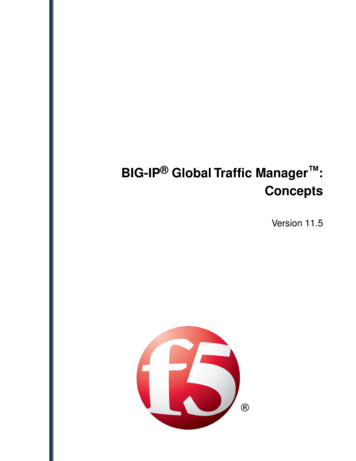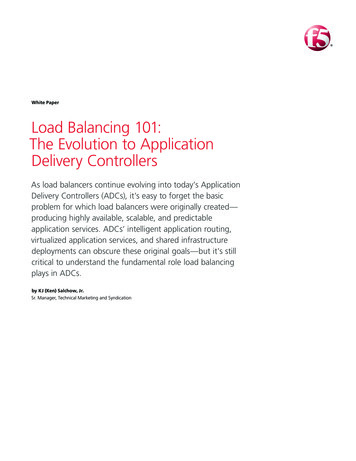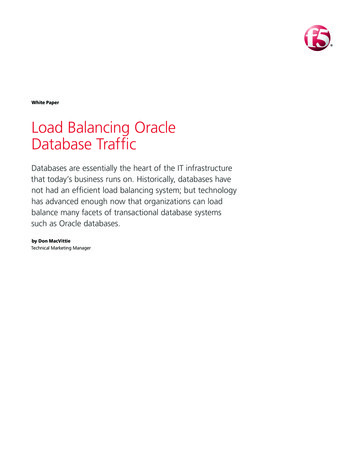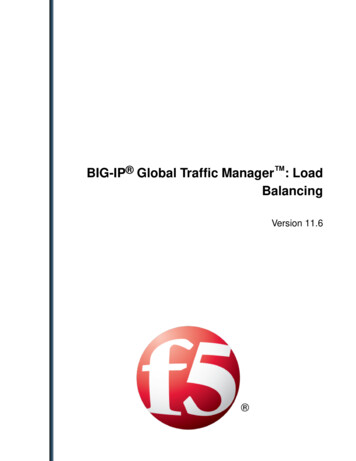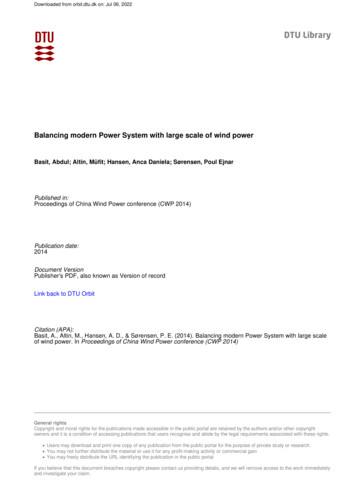
Transcription
Downloaded from orbit.dtu.dk on: Jul 06, 2022Balancing modern Power System with large scale of wind powerBasit, Abdul; Altin, Müfit; Hansen, Anca Daniela; Sørensen, Poul EjnarPublished in:Proceedings of China Wind Power conference (CWP 2014)Publication date:2014Document VersionPublisher's PDF, also known as Version of recordLink back to DTU OrbitCitation (APA):Basit, A., Altin, M., Hansen, A. D., & Sørensen, P. E. (2014). Balancing modern Power System with large scaleof wind power. In Proceedings of China Wind Power conference (CWP 2014)General rightsCopyright and moral rights for the publications made accessible in the public portal are retained by the authors and/or other copyrightowners and it is a condition of accessing publications that users recognise and abide by the legal requirements associated with these rights. Users may download and print one copy of any publication from the public portal for the purpose of private study or research. You may not further distribute the material or use it for any profit-making activity or commercial gain You may freely distribute the URL identifying the publication in the public portalIf you believe that this document breaches copyright please contact us providing details, and we will remove access to the work immediatelyand investigate your claim.
Balancing modern Power System with large scale of wind power,*,§***A. Basit1 , M. Altin , A.D. Hansen and P. Sørensen*Technical University of Denmark, Department of Wind Energy, Frederiksborgvej 399, Building 125, 4000 Roskilde, Denmark§Sino-Danish Center for Education and Research, Niels Jensens Vej 2, 8000 Aarhus, DenmarkAbstract – Power system operators must ensure robust, secure and reliable power system operation evenwith a large scale integration of wind power. Electricity generated from the intermittent wind in large proportion may impact on the control of power system balance and thus deviations in the power system frequency insmall or islanded power systems or tie line power flows in interconnected power systems. Therefore, the largescale integration of wind power into the power system strongly concerns the secure and stable grid operation.To ensure the stable power system operation, the evolving power system has to be analysed with improvedanalytical tools and techniques. This paper proposes techniques for the active power balance control in futurepower systems with the large scale wind power integration, where power balancing model provides the hourahead dispatch plan with reduced planning horizon and the real time imbalances are minimized with automaticgeneration controller and the programmed to regulate active power reserves.Keywords – Power balance control, Large scale wind power integration, AGC and Inaccurate wind forecast1 IntroductionElectricity generation from wind power has increased significantly during the last decade. Wind power isincreasingly being viewed as a mainstream electricity supply technology as it has very low CO2 lifetime emission, significantly exploitable resource potential, no cost uncertainties from fuel supply price fluctuations, canbe rapidly installed and opportunities for industrial, economic and rural development. Therefore, globally 318GW of wind power capacity has been installed till the end of 2013, where 35 GW was only installed in 2013[1]. China holds the largest capacity of wind power plants worldwide with 91.4 GW of installed wind power.Other countries having large wind power capacities are United States (61 GW), Germany (34.2 GW), Spain(22.95 GW) and India (20.15 GW) [1].Denmark being the pioneer of electricity generation from wind power is among the top 10 countries havingthe largest wind power capacity. It has worldwide the highest wind power penetration level with respect to thetotal generation, with the generating capacity of 4.79 GW [2]. The installed wind power generated 11.1 TWhduring the year 2013 and shares 33.2% of the electricity generation in the entire year, when the total electricitygeneration in the Danish grid was 33.5 TWh [2].In the future, these levels are expected to be increased according to the political and environmental policies.Therefore, large scale integration of wind power into the power system may risk the secure and stable gridoperation without consideration of the wind variability. The problems that need to be addressed include frequency control, power balance control, voltage stability, reserves and transmission capacity [3]. Frequencycontrol problems are more prominent in small and islanded power systems. Accordingly, in a large interconnected power system, such as Denmark connected to European power system, power balance is one of the mainchallenges that need to be evaluated for large scale integration of wind power. Wind power forecast contributesconsiderably to the power balance control, as the inaccurate wind forecast disrupts the cost effective generationschedule and could reduce system stability. The system operators concerns on how to integrate a significantamount of this intermittent wind power without disrupting the power system balance control.1Corresponding author: Tel.: 45 2492 1623; Fax: 45 4677 5083; E-mail address: abdl@dtu.dk (A.Basit)1
The paper presents a platform for the active power balance control in a large scale wind power integratedpower system. This methodology consists of a dynamic power system model implemented in PowerfactoryDigSilent with hour-ahead active power set values for the conventional generation and consumption, and theforecasted wind power from Simulation power Balancing (SimBa) tool. Consequently, the simulation resultswill be presented for an example of Danish power system as a benchmark of the proposed platform. A dynamicpower system model for long term dynamic simulations studies has been developed, representing relevant dynamic features of the power plants and compensates for imbalances between load and generation by regulatingthe active power production in real time. The present developed power system model includes models for theAutomatic Generation Control (AGC) system, centralised or de-centralised Combined Heat and Power plant(CHP and DCHP), Wind Power Plant (WPP) and interconnections with neighbouring power systems. The highly wind power integrated power system model is using hour-ahead schedule information on power generation,power demand and power exchange as input, with five minute dispatch plan. The hour-ahead plan is generatedby SimBa model, developed by the Danish TSO (Energinet) together with the Technical University of Denmark.The paper is structure as follows; a brief description of the impact of inaccurate wind power forecast in ahighly wind power integrated power system is provided in Section II. The implemented power system modelwith high share of wind power is then described in Section III, while power balancing techniques and simulation results are shown and analysed in Section IV. Finally, Section V draws the partial conclusions of thisstudy.2 Impact of inaccurate wind power forecastPower system must keep the supply and demand power in close balance at all times. In traditional powersystems, the average load almost varies in predictable patterns, except for the unforeseen events. These variations are compensated in real time through additional generation capacity kept as reserves. Introducing windgeneration can increase the regulation burden and need for reserves, due to its natural intermittency. Windpower impacts the reliable power system operation and it depends on their penetration level, and also on thepower system size, generation capacity mix, load variation and the interconnection with neighbouring powersystems. The intermittent nature of wind power may lead to a power balancing problems in a highly wind power integrated power system can deviate the system frequency from its nominal level and the tie line power exchange from planned and cost effective generation schedule. The large scale integration of wind power therefore challenges the system operators to maintain a close balance between production and consumption in theirindividual power systems and the tie line interchange at its schedule.Wind power forecast plays an important role in this regard, as for example. in a current Danish power system, a single m/s increase or decrease in a wind speed between 5 – 15 m/s will generate a power imbalance ofapproximate 350 MW [4]. The developed control methods and the available reserves are suitable to deal withthe variable wind power supply in the existing power systems. However, operation and control methods need tobe reviewed for future integration of wind power as wind power plants will be replacing the conventional power plants in modern power system.3 Power system modellingPower system model has been developed to study the active power balance control in a modern power system with high wind power penetration level, where more than 50% of the electricity is generated by the windpower. The developed power system model reflects the most relevant dynamics of the power system with respect to active power balancing control issues. It includes the AGC system, aggregated models for the CHP,DCHP and WPP and the interconnections with neighbouring power system, as shown in Figure 1.2
The response time and ramp rates associated with CHP and DCHP models are in order of minutes and arethe dominant characteristic for power system studies. An aggregated CHP model consists of a thermal boiler, aboiler turbine controller, a steam turbine and a speed governor, while, an aggregated DCHP model includes gasturbine and a speed governor. The speed governor of the generating units activates the primary reserves, i.e.Frequency Containment Reserves (FCR), if the frequency deviates by 0.01 Hz. The amount of FCR dependson the droop characteristic of the governor of each generating unit (i.e. 4% in this study) and the available capacity. The reference power signal for the conventional generating units is calculated from the hour-aheadschedule generated by SimBa and the power correction from the AGC, i.e. Frequency Restoration Reserves(FRR). The CHP power plant also activates the regulating reserves, i.e. Replacement Reserves (RR), to reducethe real time imbalance in the power system.Figure 1: Power system modelAn aggregated WPP model is also modelled for the active power control purpose, where the power reference is decided based on the available wind power, primary response and the secondary response from anAGC.4 Techniques for balancing power system operationIn deregulated power systems, the electricity is traded in electricity markets by the balance responsiblecompanies that can produce, consume or retail. The balance responsible balances the power system for everyoperating period to one hour in advance of the actual operation hour. The unpredictable wind nature or othernon-contingent events might create power imbalance within the actual operating hour. These imbalances arethen minimized in real time by primary and secondary responses and also by activating the reserve power,within minutes, from regulating power market.To study the power system balance operation with large scale of wind power, a specific day is consideredwhen conventional power plants generated 33.15 GWh of electricity, while wind power generated 43.22 GWh,i.e. 56.59% of the total electricity production, with total load demand of 43.76 GWh. The hour-ahead balancepower schedule is provided by SimBa and the real time imbalances are compensated by varying the productionfrom CHP and WPP using an AGC and also by programmed control of regulating reserves.4.1Hour-head balancing operationConventional market models are simulating optimal unit commitment and dispatch of generation units withone hour resolution, based on input time series for consumption and renewable power generation [5]. Howeverto cope with the inaccurate wind power forecast in a highly wind power integrated power system, it is neededto activate the dispatch power with reduced planning horizon in order to decrease the real time regulating burden. SimBa releases an hour-ahead dispatch plan in a time scale of five minutes to manage the power imbalances in a highly wind power integrated power system. It takes hour-ahead wind power forecasts, estimates thewind power fluctuation within each operating hour and calculates the available wind power with a five minute3
time resolution. Based on the simulated hour-ahead wind power forecast and the day-ahead power productionplan from the spot market, it provides dispatch plan for generating units and power exchange with neighbouring power system. However due to the uncertain nature of wind, the wind power within the operating hour maynot be the same as its estimated value and this aspect can create power imbalance within the operating hour.The amount of power imbalance seen by the developed power system model in this study, using hour-aheadschedule from SimBa, is shown in Figure 2. The figure also shows the hour-ahead wind power forecast errorduring the same period.Figure 2: Power imbalance and wind forecast errorThe power imbalance within the operating hour is due to the hour-ahead wind power forecast error, as Figure 2 compares the two power imbalances. The power imbalance will deviate the system frequency from itsnominal level and the interchange power from hour-ahead schedule. The power imbalance is minimized in realtime by adjusting the production from CHP and WPP in real time.4.2Real time balance operationActive power reserves are always needed to keep the power system in balance and their amount depends also on the wind power penetration level and wind power forecast. The reserves are typically needed from fastconventional generating units to increase the system reliability and to ensure the power supply security. According to European Network of Transmission System Operators for Electricity (ENTSO-E), the type of reserves needed to keep the power system in balance can be classified as FCR, FRR and RR. In this study, theFCR is activated from all generating units; FRR is automatically activated from CHP and WPP through anAGC and RR only from CHP.The generating units of the developed power system model responds to the power imbalance shown in Figure 2, by activating the FCR within 30 seconds for constant containment of frequency deviations and to constantly maintain the power balance in the whole synchronously interconnected system. The AGC respondsafterwards and activates the FRR within 5 – 10 minutes, in order to maintain the active power balance in thepower system and the power exchange with neighbouring power system at its schedule. The activation of FRRwill also replace the FCR. Figure 3 shows and compare the power imbalance in the power system after theactivation of FRR and the hour-ahead power imbalance.Figure 3: Power imbalance after FRR4
The AGC activates the FCR with a coordinated control strategy between the CHP and the WPP. The CHPparticipate in up or down active power regulation, whereas the AGC down regulates the active power production from WPP only in case of generation excess and when CHP operate at their minimum limits or CHP dispatch reaches its lower limit. The AGC strategy integrates the WPP efficiently in secondary control by downregulating their production only in case of generation excess and utilizes the available wind power in case ofgeneration deficiency.The remaining power imbalance after the AGC response is minimized by the programmed activation of RR.These reserves are activated from CHP by an algorithm, designed to simulate the actions similar to the controlroom to tackle the real time power imbalances. The developed algorithm activates the regulating bids to reducethe real time power imbalances in the power system and make power system operation more reliable. The power imbalance after the activation of RR is compared in Figure 4 with the hour-ahead power imbalance and thepower imbalance after AGC response. It can be seen that the imbalance has substantially reduced in a powersystem, where more than 50% of the total electricity is generated by wind power.Figure 4: Final Power Imbalance5 ConclusionThe integration of large amounts of wind power into the power system results in an extraordinary challenges e.g. power system balance control. The regulating reserves and its effective control are always needed tomaintain active power in close balance. This paper proposes a platform for active power balance control, wherehour-ahead dispatch plan with reduced planning horizon minimizes the real time regulation burden and theAGC with programmed control of regulating reserves makes the power system operation more reliable. Thestudy performed and presented in this paper shows how power imbalances between load and generation, causedby wind power forecast error, can be compensated effectively by regulating the power from CHP and WPP inreal time. The algorithm activates the regulating power from CHP while the AGC provides the required secondary response from CHP and WPP. However, better forecasting of wind speed and the load demand is stilldesirable for operational security of highly wind power integrated power system.AcknowledgementThis paper is a part of PhD project funded by Sino-Danish center for education and research (SDC).References[1] Global Wind Energy Council, “Global Wind Statics 4/02/GWEC-PRstats-2013 EN.pdfFebruary2014[online],[2] Vittrup C, "2013 was a record-setting year for Danish wind power" Energinet.dk, 15 January 2014 13-var-et-rekordaar-for-dansk-vindkraft.aspx[3] Suwannarat A (2007), “Integration and Control of Wind Farms in the Danish Electricity System,” Instituteof Energy Technology Aalborg University, Aalborg5
er%20magazine.pdf[5] Sørensen P, Norheim I, Meibom P and Uhlen K (2007), “Simulations of wind power integration with complementary power system planning tools,” Electric Power Systems Research, p. 1069–10796
GW of wind power capacity has been installed till the end of 2013, where 35 GW was only installed in 2013 [1]. China holds the largest capacity of wind power plants worldwide with 91.4 GW of installed wind power. Other countries having large wind power capacities are United States (61 GW), Germany (34.2 GW), Spain (22.95 GW) and India (20.15 GW .
